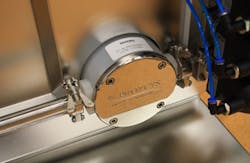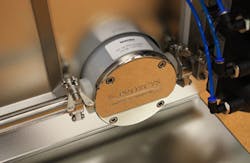By Dr. Andreas Frerix
"The difficulty with my former employer was that it didn’t see the necessity, or the possibility, to innovate the radial columns," says Raedts, the founder, president and CEO of PROXCYS Downstream Biosystems, Nieuw Amsterdam, The Netherlands. He approached his former bosses with a potentially better solution that involved changing the design of the RFC columns, but was rebuffed. That led to his decision to start his own company.
In biopharmaceutical production, upstream processing is where medicine-producing cells are cultivated until the proper amount is produced. In the downstream process, the desired active pharmaceutical ingredient (API) with potential pharmaceutical use is separated from the cell fragments and other culture media present upstream.
Chromatography offers one of the more popular and effective ways to make this happen. A chromatography-column system accomplishes purification by selectively adsorbing target molecules — the API — onto the chromatography media packed in a column. To perform this task, the chromatography column is carefully packed with a media (or resin) that can cost as much as $10,000 per liter. The process requires a high, constant flow rate and is operated at moderate pressure.
Typical chromatography-column design is "axial." In other words, the chromatographic media are packed in a rather flat, broad, pancake-like cylinder, with the liquid stream passing through it vertically, from top to bottom or vice versa. The result is a system that has a short, wide bed that is highly inefficient in terms of the space required, as well as its overall weight being an encumbrance. Therefore, in axial chromatography, packed beds are typically taller than necessary in order to reduce the diameter of the axial columns, with an accepted tradeoff: reduced throughput and increased operating pressure.
Over time, Raedts became familiar with an alternative to traditional axial-flow systems: Radial Flow Chromatography (RFC) columns. RFC columns offer increased throughput and reduced pressure drop, while the system’s weight and footprint can be one-quarter that of an axial-flow column. Existing RFC-column technology performed only "moderately well" and Raedts determined that the columns should be able to perform much better, if they were properly designed.
A radical — and radial — idea
Founded in 2003, "PROXCYS was started from our garage, which is not untypical for American companies, but is quite untypical for this kind of company in Holland," Raedts says.
The RFC itself was actually invented in the 1950s. It can be an efficient, low-pressure technology ideal for bio-molecule fractionation and purification. Unlike axial-flow systems, where the liquid stream passes through the chromatography media vertically, RFC sees the media wrapped around a central cylinder, with the liquid stream passing through it horizontally. RFC essentially folds the horizontal bed of the axial system into a vertical cylinder and changes the flow direction from vertical to horizontal. While the purification and fractionation capabilities remain the same, the system’s footprint and weight are radically reduced.
"The performance of PROXCYS’ RFC compares well to the best axial columns on the market and they could be interchanged, but in practice that’s more difficult," Raedts says. "The manufacture of pharmaceutical products is highly regulated, so if you change the way you do things, there are a lot of hurdles to overcome, starting with new clinical trials."
Still, there is an increasing acceptance of and more frequent changeovers to RFC from axial columns because RFC performance is proven to be equal to or better than axial columns. In addition, there are operational benefits from the RFC’s small footprint, short bed height, ease of packing, low pressure drop and high productivity rates.
"In new processes where operators can freely choose their own systems, the benefits of our RFC columns are highly appreciated," says Raedts. "Innovation of RFC columns began in 2002 and the development of the current patented Annular Port packing system in 2006 was key to dramatically improving performance. That was when we could launch our first innovative column, a five-liter high-performance RFC column that today has been scaled up to many sizes and options."
Proper pump for the process
A critical step in optimizing the performance of an RFC column is the packing of the chromatography media, typically a resin, into the column. In the search for the proper pumping solutions, Raedts was introduced to quaternary diaphragm pumps from Quattroflow Fluid Systems GmbH & Co., Kamp-Lintfort, Germany.
Much like Raedts, who went out on his own to found PROXCYS, Quattroflow came into being in 2000 when engineers Frank Glabiszewski and Josef Zitron realized there had to be a better pump for critical product-handling applications in the pharmaceutical and biotech industries. They developed a positive displacement quaternary pump that features four pistons and four smooth-operating diaphragms, a design similar in concept to that of the human heart. In 2012, Quattroflow was acquired by the Dover Corp. and became a member of Dover’s Pump Solutions Group, Oakbrook Terrace, Ill.
"When we first got the Quattroflow pump, we were using it for typical downstream operation of RFC columns," Raedts says. "There, we discovered the attributes that make the Quattroflow an excellent pump: low pulsation, gentle product handling, large turndown ratio, high accuracy, low noise, compact design and low-shear operation."
During a trial run with a packing pump, Raedts and others decided to include the Quattroflow pump to see how it compared to the other pumps typically used in column packing, usually compressed-air dual-action membrane pumps and peristaltic hose pumps.
"The Quattroflow pump performed much better than we expected and showed highly reduced resin damage," Raedts says. "Since it has four diaphragms and five valves we expected some additional shear, but there was none at all, even at elevated flow rates. There was truly a strong similarity to the human heart in its operation and that provided proof of its suitability for demanding applications like human blood plasma fractionation. Additionally, we found an excellent clearance of any undesired residues from the pump head."
Most air-driven pumps are noisy, have a limited turndown ratio, pulsate and are relatively inaccurate. They are not suitable for downstream column operation. The Quattroflow pump does not exhibit these characteristics and actually enabled PROXCYS to develop a new product: the Pack & Run system, which features a very small footprint.
Pack and run
The Pack & Run system allows for the completion of two critical operations within the biopharmaceutical-production process:
- High flow-rate packing of the chromatography media in an RFC column via gentle yet fast handling without pulsation or shear; and
- Low flow-rate Height Equivalent to Theoretical Plate (HETP) testing to verify that the column has been packed correctly.
The Pack & Run system can also be used for the handling of biologics through a third critical operation, a medium flow rate for downstream processing of plasma proteins, which are very shear- and pressure-sensitive.
"It is very uncommon for a system to be able to perform both column-packing and an HETP test, but the pump is able to do so," says Raedts. "The key to this versatility is the large turndown ratio, low shear and excellent head clearance." This last attribute is most important in allowing the completion of the third critical area of operation, the processing of plasma proteins.
"Our Pack & Run systems are currently used in Phase I and II clinical manufacture of plasma protein: one tiny, floor-space demanding system that can do it all," says Raedts. "This is not typical, especially since the processing of the clotting factors and other plasma protein is a very delicate matter. The Quattroflow pumps have also been shown to perform capably at very slow to very fast speeds, but without any noticeable increase in shear."
Since the early days when PROXCYS was offering its first five-liter column, the company has grown to design and construct RFC columns with up to 350 liters (92 gallons) of column volume. It therefore makes use of four sizes of pumps with increasing flow rates.
Raedts anticipates the day in the next year when PROXCYS will begin producing a 1,200-liter column, which would be the largest in the world.
Concluding thoughts
Marcel Raedts took an undeniable leap of faith when he went against accepted practice and formed his own company. Now, what began as a dream in his garage 10 years ago, has grown into a company with an increasingly international reach.
In September 2012, PROXCYS became the official distributor of Quattroflow pumps in the Benelux (Belgium, The Netherlands and Luxembourg) countries. Including the full line of Quattroflow Quaternary diaphragm pumps has been an important addition to the PROXCYS product family.
"Quattroflow is definitely helping our clients," Raedts says. "Until two years ago, we were not applying the pumps into any of our systems because at the time we only had simple packing skids using air-membrane pumps like everyone else. But a simple test to compare the performance of the Quattroflow pump for column packing radically changed the landscape."
Knowing what was possible, PROXCYS found a client who understood its vision and after presenting the first design with a Quattroflow pump, they were thrilled to go with that. "Now, Quattroflow is a product that really helps our sales, maybe as much as 30%," Raedts concludes.
Dr. Andreas Frerix is the applications manager Biotech/Biopharma for Quattroflow, part of Pump Solutions Group (PSG®). He can be reached at [email protected].

